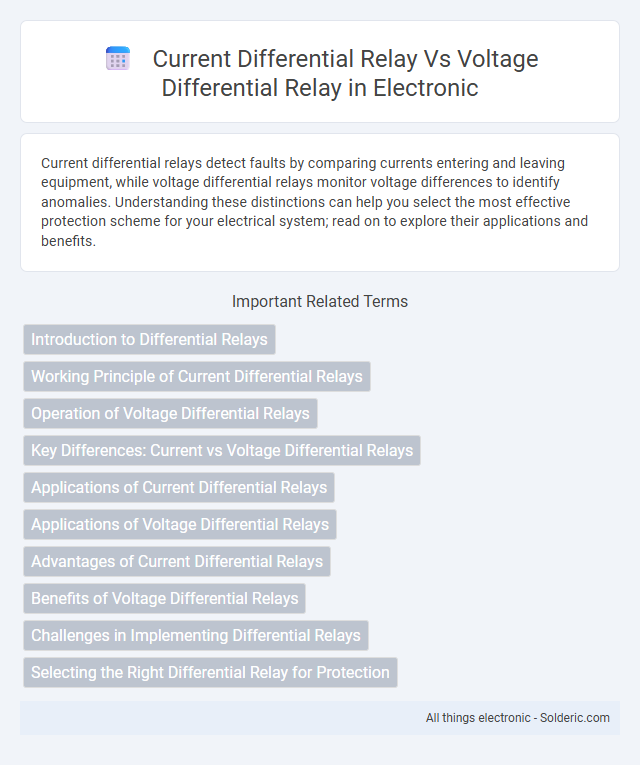Current differential relays detect faults by comparing currents entering and leaving equipment, while voltage differential relays monitor voltage differences to identify anomalies. Understanding these distinctions can help you select the most effective protection scheme for your electrical system; read on to explore their applications and benefits.
Comparison Table
| Feature | Current Differential Relay | Voltage Differential Relay |
|---|---|---|
| Function | Detects faults by comparing current differences between line ends. | Detects faults by comparing voltage differences across protected zone. |
| Application | Commonly used in transformers, generators, and transmission lines. | Used in specialized systems like busbars and specific transformer protection. |
| Sensitivity | Highly sensitive to internal faults with minimal external disturbance. | Sensitive to voltage unbalance and phase discrepancies. |
| Measurement | Measures differential current; compares input and output currents. | Measures differential voltage; compares voltages at both ends. |
| False Operation Risk | Possible during CT saturation or external fault current leakage. | Possible due to transient voltages or capacitive coupling. |
| Typical Installation | Installed on primary circuit with CTs at both ends. | Installed on voltage circuit with voltage transformers (VTs) at both ends. |
| Response Time | Fast, typically milliseconds. | Variable, often slightly slower than current differential relays. |
| Cost | Generally lower cost due to widespread application and technology. | Higher cost due to specialized equipment and installation. |
| Protection Zone | Strictly covers the protected zone defined by current measurement. | May cover wider area depending on voltage measurement points. |
Introduction to Differential Relays
Differential relays protect electrical equipment by comparing current or voltage inputs from multiple points and detecting discrepancies that indicate faults. Current differential relays monitor the difference in current between two or more locations, typically used in transformers and busbars to identify short circuits or ground faults. Voltage differential relays measure voltage differences across equipment, providing sensitive detection of insulation failures or relay malfunctions in power systems.
Working Principle of Current Differential Relays
Current differential relays operate by comparing the current entering and leaving a protected electrical zone, detecting faults when the difference exceeds a preset threshold. They measure the magnitude and phase angle of currents from multiple points, triggering protection if discrepancies indicate faults like short circuits or equipment failures. Your power system benefits from rapid fault detection and isolation, minimizing damage and ensuring stability.
Operation of Voltage Differential Relays
Voltage differential relays operate by comparing the voltage difference between two or more points within an electrical system to detect faults, ensuring rapid isolation of the affected section. These relays measure the phase angle and magnitude variations of voltages, activating protection mechanisms when discrepancies exceed preset thresholds. Your power system benefits from enhanced fault detection sensitivity and selectivity through the precise operation of voltage differential relays.
Key Differences: Current vs Voltage Differential Relays
Current differential relays detect faults by comparing the difference in current between two or more points on a power system, ensuring rapid and selective protection. Voltage differential relays, on the other hand, operate by monitoring voltage differences across equipment, providing sensitivity to faults without requiring high current flow. Understanding these key differences helps you choose the appropriate relay type based on system requirements and fault characteristics for optimal protection.
Applications of Current Differential Relays
Current differential relays are widely used in power system protection to detect faults within transformers, generators, and transmission lines by comparing current values at different points. These relays provide rapid fault isolation by monitoring differential currents, offering high sensitivity and selectivity for internal faults while minimizing false tripping from external disturbances. Voltage differential relays, by contrast, are less common but primarily applied in specialized scenarios requiring voltage comparison across equipment, with current differential relays dominating due to their reliability and precision in fault detection.
Applications of Voltage Differential Relays
Voltage differential relays are primarily applied in power transformer protection and busbar fault detection, where they monitor voltage differences to identify internal faults and abnormal operating conditions. These relays offer enhanced sensitivity in detecting phase-to-phase or phase-to-ground faults compared to current differential relays, making them suitable for complex substation configurations and high-voltage networks. By accurately isolating faulted sections, voltage differential relays contribute to improved system stability and reduced outage durations in electrical power systems.
Advantages of Current Differential Relays
Current differential relays offer superior sensitivity and fast fault detection by directly comparing current measurements from multiple points in a protected zone. They provide higher stability under normal operating conditions and better immunity to CT saturation and measurement errors compared to voltage differential relays. Enhanced protection selectivity and reduced false tripping are achieved due to the robust current-based detection method.
Benefits of Voltage Differential Relays
Voltage differential relays provide enhanced sensitivity to internal faults in power systems by detecting voltage imbalances rather than current differences, leading to faster and more accurate fault isolation. They offer improved stability during external fault conditions, reducing the risk of false tripping compared to current differential relays. The ability to better discriminate between internal and external disturbances results in increased system reliability and reduced downtime.
Challenges in Implementing Differential Relays
Differential relays face challenges such as sensitivity to CT saturation, requiring precise current transformer matching to avoid false trips. Voltage differential relays encounter difficulties with voltage transformer accuracy and transient overvoltages that can compromise stability. Both relay types must address issues related to signal noise and high-frequency disturbances to ensure reliable protection performance.
Selecting the Right Differential Relay for Protection
Selecting the right differential relay for protection involves understanding the specific requirements of the power system. Current differential relays are primarily used for detecting faults by comparing currents at different points, offering sensitive and fast fault detection in transformers and generators. Voltage differential relays, on the other hand, monitor voltage differences to identify abnormalities, making them suitable for applications where voltage imbalance or phase shifts need precise monitoring.
current differential relay vs voltage differential relay Infographic

 solderic.com
solderic.com